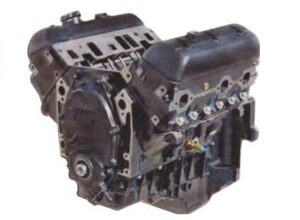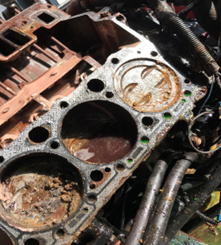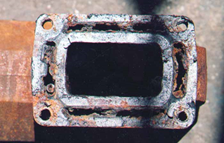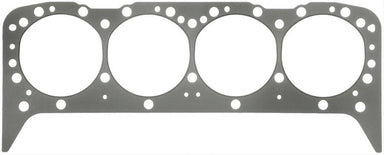Marine Longblock Buying Guide
Marine Longblock Buying Guide
By Roger Polak – Marine Spares Direct
Welcome to the first in our buyer’s guides and information articles all about boating and how to be an informed customer.
As we all know boating is great fun! But what do you do when it all goes wrong and encounter that horrible day when you have to get towed in?
In this guide we are covering longblock engines and what you need to know before you buy one to repower your inboard or sterndrive boat.
Contents
- What is a longblock
- Why did my engine fail
- So I need a longblock. Where do I start
- The questions you need to ask
- How to choose the best replacement longblock
- Beware! Things to look out for
- Putting it all together
- What is a longblock
The longblock in the mechanical heart of your engine. It includes the engine block, crankshaft, pistons, heads, valve train, camshaft and more. The longblock is a complete unit minus the ignition system, fuel system and accessories like water pumps, starter motors, belts, pulleys and computer systems. They typically look like this.

They are complete from the sump at the bottom, up to the rocker covers at the top. The simpler version is a short motor, which doesn’t have heads or rocker covers. Some will be missing the sump also.
At the other end of the scale is the complete ‘bobtail’ engine, which is a complete ready to run engine. We will only be talking about the longblock here as it’s often the simplest and most cost effective way to get you boating again.
- Why did my engine fail
Anyone who has had a boat breakdown knows the horror of the situation. One minute you’re landing monster flatties (maybe even a 3 metery!) and the next minute your floating, no power and she refuses to start. Unlike a car you can’t just pull over to the side of the road and wait for help. No, this just officially turned into a bastard of a day!

One very sad engine
Over the years we’ve seen it all and here are some of the common reasons she no go now.
- Lack of maintenance. Just because it was all good 6 months ago doesn’t mean things are still all sweet. Regular maintenance from qualified marine mechanical services is so important. They will get to know your boat and advise you when things need servicing or repair.
- Mechanical failure. Things do break and wear out. Engines from original manufacturers like Mercruiser and Volvo Penta have a long history of excellent reliability. But that doesn’t mean they can’t fail. Particularly if not looked after. So it happens, more so as she gets older.
- Failure of other parts. When it comes to these engines. Anything that lets water into the engine spells massive trouble! There’s cracked heads, gasket failures and then one of the most common causes of engine failure.
- Failed exhaust manifolds and risers! This accounts for up to 80% of longblock engine failures. So you need to keep exhaust manifolds and risers in tip-top condition and if in doubt, replace them before they stuff everything up.
.

These exhausts are trashed. In the bin they go!
We will go into how to spot problems in a future guide, including what to look for when you buy a secondhand boat. But for now. Forget CPR and even well worded prayers. The patient is dead. Time to send her off with a decent wake.
- So I need a longblock. Where do I start
First step would be to talk to your marine mechanic. They will want to examine the engine and find out what went wrong. One myth is that mechanics love the smell of a stuffed engine because it’s an expensive job. Sure they need to work like anyone, but the last thing your mechanic wants to see is their customers giving up on boating and listing it on Gumtree.
The next step you’ve already taken. Since you’re here on the internet boning up on information. We massively encourage research because you really do need to be informed as best you can before spending the cash on a replacement longblock.
Your choices largely come down to these.
- Secondhand replacement. Very hard to recommend. Will probably be cheaper but can land you right back in trouble again.
- New genuine replacement. By all means enquire and price up a new Volvo or Mercruiser option. It will likely be the more expensive option, but they make quality products.
- Aftermarket replacement longblocks. Here’s where you will have more options and careful research will mean you get the right replacement longblock – the first time!
One important thing to save time and money is only look at marine longblocks. They are built differently to car engines and so a crate automotive engine isn’t the go. Marine engines use special marine gaskets and other marine grade parts. They are what you want.

Not all head gaskets are the same – this one is a marine version
- What questions do I need to ask?
Good question!
Here’s where the research you do and the decisions you make start to make a difference. You want the best product for your money, right? We all do. And that’s where the questions you ask the supplier and the answers you get make a massive difference.
Every supplier is going to say their engines are the best. Of course they will!
But you can ask the right questions to get a feel for what’s really on offer. Try these for a start and see what answers you get.
- What exactly is my engine?
A skilled mechanic or spare parts manager should be able to pinpoint the engine you have and then be able to recommend a replacement. The right replacement. Ask about the credentials of the person you are speaking to. What is their experience in the marine industry and what background do they have? You don’t want some ill-informed kid fresh out of school or someone who started doing this last week giving you advice!
- What’s the price?
Ok, so this is one of the big questions. Sure, you want a good price. But as the old saying goes. When things are cheap, they are cheap a reason. As an example. . . .Sure you can buy a hacksaw blade for $1 or one that looks pretty much the same for $5. Ever used a cheap hacksaw blade? Pretty much sucked yes! So price isn’t everything. It’s price Vs quality.
- Tell me what new parts are included and where they came from?
As in the hacksaw example, having cheap (often Chinese) engine parts make an engine cheaper. But the quality can suffer too. Examples of cheap parts you would rather not have include heads, lifters and pistons. Any failure with these will lead to nasty problems. You want your engine built with quality parts, not just the cheapest parts.
- Who builds the engine at any stage and are they a qualified engine builder?
Building a great engine takes great skill. It’s not something that gets picked up overnight. For example, our Marine Spares Direct engines come from the US, use US sourced parts and are built only by qualified engine builders. They’ve been building marine engines since the 1970s. No corners are cut and the result is a dependable engine backed by one of the biggest US suppliers and an Australian support team.
- What are the reviews like?
Google reviews show up when people are either really happy, or severely unhappy. Use previous customers’ experience to help guide you. Also make sure the reviews are genuine. Fake positive reviews are easy to spot, and they are out there. Often too glowing, written by friends and family and often are posted on the same day, when that business is trying to bury the 1-star reviews. While you are at it, maybe try and get the opinions of marine installers who are local to the supplier. These guys always have their ears to the ground and can stop you from making a costly mistake!
- What’s the warranty situation?
A reputable business will spell out exactly what is covered and the extent of the warranty before you buy. If it’s not very inclusive or you fear you will be left in the lurch then walkaway. Just being told ‘mate – you’ll be covered!’ isn’t good enough. The details matter here.
- Who can fit my engine?
The best result is usually someone qualified who is local to you. They can point out any other issues they see and get you on the track to reliable maintenance. They may even offer you a beer from time to time!
- What’s the delivery time?
There’s nothing worse than being strung along. Make the supplier come up with a timeline and ensure they stick to it. If they can’t produce what they said they would, you’d have to wonder why. At Marine Spares Direct we don’t have that problem of course, as our marine engines are imported directly from the US by container loads and in stock and ready to ship the same day.
- How to choose the best replacement longblock
So now you are well on the way to being an informed customer.
You’ve spoken to some knowledgeable and experienced marine experts who are old hands at this. Good stuff!
Next you need to throw all that information in the air and pick out the good bits. Right now we will give you a backstage pass to weed out the things that matter from the things that don’t.
- The block is the building block for your entire engine. Get a good one and it’s the cornerstone of a long-lasting engine. But in Australia, that’s a problem. The most popular engine sizes in Mercruiser and Volvo are the 4.3L V6, the 5.0L V8, 5.7L V8 and 6.2L V8. These engines were never sold widely in in Australia outside the marine sector. So, the block you get in an Australian remanufactured engine has quite likely already done a lifetime’s work all in sea water with the potential corrosion that can cause. In the US (which is the home of Mercruiser) those engines were sold in cars and other applications, so the reman industry has a wide range of later model blocks to choose from. They can afford to reject blocks that aren’t ideal, because there are 1000s and 1000s available. The result is US produced reman longblocks are on small bores, never been previously bored out and never seen a single day of salt water use. They don’t just have to use whatever they can get their hands on. That makes them a much better choice.
- The best internal parts are what you want. Many of the parts that go into these engines aren’t that easily available in Australia. Because the engines weren’t widely used in cars. Things like gasket sets are. But, it is common for the Australian builders (not all of course) to reach out to China, because that’s where the cheapest imitation parts are made. Then you get them in the engine you buy. Of course it’s you, the consumer’s choice. But what heads would you rather have in your engine? Genuine remanufactured? Or cheap Chinese knock offs?
- Next step is building the engine. There are some fantastic skilled engine builders in Australia, but not many in the marine sector. A few excellent builders spring to mind, who tend to run small operations of their own. That way they keep the quality control right up there. As with most things in the US, it all happens on a much bigger scale. So for instance our US imported engines are built only by qualified tradesmen.
- Quality control. This is one of the most important factors in an engine build. Our US builders have all the right machinery in-house to build the engines. Not just a few hand tools and rough equipment to complete the job.
- Major US marine engine building companies have the facilities to spin up and test the engine before sending it out the door. The engine isn’t actually started, because it is a long block and not a complete engine with fuel system, ignition etc. So for instance our imported engines are run on a professional test rig to check compression, leaks, vibration etc. If this isn’t done, then the first time your engine is spun over at all is when it is fired up. If there’s a problem then you’re back to square one!
- New longblocks. There also brand new longblocks available. The key word here is ‘new’. That means the entire engine needs to be new. So new internals, new bolts, new sump, new rocker covers. No used parts at all. If you’re buying new. Make sure you ask the seller if the engine is indeed 100% new. Then check that’s actually the case when you receive it.
- Beware! Things to look out for!
We will keep this short and simple. But in our experience, it pays to be aware of things like
- Dodgy discounting. You wouldn’t expect a quality and reputable supplier to discount like crazy. If their products really are that good why do they need to slash pricing to sell them?
- False claims. If you find out later down the track the engine that is already in your boat isn’t up to scratch, what can you really do about it? Not much most likely.
- Yes, that’s right paint! It can hide almost anything and so closely inspect the engine when you get it and look for tell-tale paint covering things up.
- Demands for progress payments. It’s not a house. It’s an engine and so unscrupulous suppliers sometimes badger you for extra money long before the engine is ready to go. As mentioned, our engines are in stock so we don’t hit you up after the initial deal is done. It’s more like buying a car. You put a deposit down to commit to the purchase, then pay before it leaves the warehouse. We don’t have to pay for the parts as we go, we already have the engines in stock. This is far better than funding an engine builder who might be depending on your $$$ to fund their purchase of the bits for your build, or worse the engines being built before yours.
- Spam advertising. If a company seems desperate to get your sale through tons of spam advertising (often with inconsistent pricing and details), well that has to make you wonder. Why are they doing that? Reputable companies don’t have to come up with over the top advertising. If it looks too good to be true it probably is!
- Putting it all back together
So, after that you’ve bought your longblock and it’s a ripper! But, it still has to go back together. The plan all along was to reuse as much of your existing engine as you can, therefore keeping the project cost down.
If your marine mechanic is building the engine back up to completion (which we call dressing the engine) he will tell you what, if anything extra, you might need. This saves you replacing parts that were still good.
That said, things like manifolds and risers are always worth looking at, as well as the fuel injectors. It’s not expensive to get them cleaned and tested by a specialist and there are places that do this right around Australia.
If you’re doing the job yourself consult with the engine supplier as you go. At Marine Spares Direct we can talk you through the process and help you solve any issues you come across. Plus we can supply any additional parts you need. We don’t sell anything second hand so we will ensure you get the right part for the job in the right condition too!
We can also recommend a marine mechanic in your area if you’re still not sure how to proceed.
Lastly the water test.
This is where it all comes together. Your mechanic will likely do this for you and sort any little issues they find. And then you’re done. Don’t forget to fill out and return your warranty paperwork and then let’s go fishing!
About the author. Roger Polak has been involved in the marine and recreational vehicle industry for over 30 years. He is also a certified marine technician as well highly experienced in the parts supply side of the industry, having been frontline in parts for Mercruiser, Volvo Penta, Evinrude and Honda dealers. Roger currently heads up Marine Spares Direct supplying marine parts, marine engines and major components such as manifolds and risers.
Our articles are also proofread by some of the best marine mechanics in Australia, to fact check and make sure the article is accurate. We do this every time.
(C) Copyright Marine Spares Direct 2024. No part of this article may be copied or reproduced without the author’s permission.
